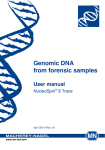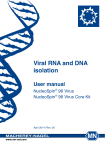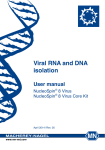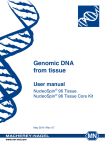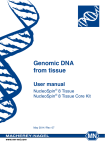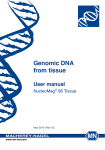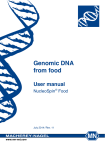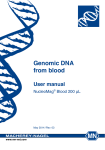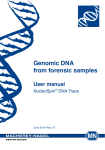Download NucleoSpin® 96 Trace - MACHEREY
Transcript
Genomic DNA from forensic samples User manual NucleoSpin® 96 Trace April 2014 / Rev. 03 Genomic DNA from forensic samples Table of contents 1 Components 4 1.1 Kit contents 4 1.2 Reagent to be supplied by user 4 2 Product description 5 2.1 The basic principle 5 2.2 Kit specifications 5 2.3 Required hardware 6 3 Storage conditions and preparation of working solutions 8 4 Safety instructions 9 5Protocols 11 5.1NucleoSpin 96 Trace – vacuum processing ® 11 5.2NucleoSpin 96 Trace – centrifuge processing 17 5.3NucleoSpin® 96 Trace – use of the NucleoSpin® Trace Filter Plate 20 ® 6Appendix 21 6.1Troubleshooting 21 6.2 Ordering information 22 6.3 Product use restriction / warranty 23 MACHEREY-NAGEL – 04/ 2014, Rev. 03 3 Genomic DNA from forensic samples 1 Components 1.1 Kit contents NucleoSpin® 96 Trace 2 x 96 preps 4 x 96 preps 740726.2 740726.4 Lysis Buffer FLB 200 mL 2 x 200 mL Wash Buffer B5 (Concentrate)1 100 mL 2 x 100 mL Elution Buffer BE2 125 mL 2 x 125 mL 2 x 33 mg 4 x 33 mg 8 mL 15 mL NucleoSpin® Trace Binding Plates (gray rings) 2 4 MN Wash Plates (including six paper sheets) 2 4 MN Square-well Bocks 2 4 Rack of Tube Strips3 2 4 User manual 1 1 REF Proteinase K (lyophilized)1 Proteinase Buffer PB 1.2 Reagent to be supplied by user • 96–100 % ethanol For more detailed information regarding special hardware required for centrifuge or vacuum processing, please see section 2.3. 1 2 3 For preparation of working solutions and storage conditions, see section 3. Elution Buffer BE: 5 mM Tris/HCl, pH 8.5 Set of 1 rack, 12 strips with 8 tubes each, Cap Strips included 4 MACHEREY-NAGEL – 04/ 2014, Rev. 03 Genomic DNA from forensic samples 2 Product description 2.1 The basic principle With the NucleoSpin® 96 Trace method, genomic DNA is prepared from forensic samples. Lysis is achieved by incubation of samples in a solution containing chaotropic ions in the presence of Proteinase K at room temperature. Appropriate conditions for binding of DNA to the silica membrane in the NucleoSpin® Trace Binding Plate are created by addition of isopropanol to the lysate. The binding process is reversible and specific to nucleic acids. Contaminations are removed by two washing steps with ethanolic buffer. Pure genomic DNA is finally eluted under low ionic strength conditions in a slightly alkaline elution buffer. 2.2 Kit specifications • NucleoSpin® 96 Trace is designed for the rapid, small-scale preparation of highly pure genomic DNA from forensic samples. The obtained DNA can be used directly as template for PCR. • Typically yields of 1–2 μg genomic DNA can be purified from buccal swabs. • The final concentration of eluted DNA is 10–20 ng/μL (depending on elution buffer volume). Typically, the A260/A280 ratio is 1.8–1.9. • NucleoSpin® 96 Trace can be processed under vacuum or in a centrifuge (see section 2.3). Table 1: Kit specifications at a glance Parameters NucleoSpin® 96 Trace Technology Silica-membrane technology Format Processing Sample material Fragment size Typical yield A260 / A280 Elution volume 96-well plate Manual or automated, vacuum or centrifugation Forensic samples, buccal swabs, blood spots 200 bp–approx. 50 kbp Depending on sample amount 1.8–1.9 50–100 μL Preparation time 70 min/plate (excl. lysis) Binding capacity 20 μg MACHEREY-NAGEL – 04/ 2014, Rev. 03 5 Genomic DNA from forensic samples • Forensic quality product: NucleoSpin® 96 Trace is certified as forensic quality product. Consumables used in forensics need to be treated carefully to prevent DNA contamination. MACHEREY-NAGEL therefore has a stringently controlled production process to avoid DNA contamination of consumables. Further, MACHEREY-NAGEL uses ethylene oxide (EO) treatment to remove amplifiable DNA, which might still be introduced during the manufacturing process. MACHEREY-NAGEL products carrying the forensic quality seal, contain plastic materials that are EO treated. This means, DNA of any kind, which might still be introduced into plastic consumables during the production process, is inactivated by means of the treatment with ethylene oxide, in order to prevent the generation of accidental human profile by PCR amplification. Ethylene oxide treatment has been shown to be the method of choice to prevent DNA profiles due to DNA contamination. (Shaw et al., 2008). Figure 1: According to Shaw et al., 2008, Comparison of the effects of sterilization techniques on subsequent DNA profiling. Int J Legal Med 122: 29-33. 2.3 Required hardware Vacuum processing The NucleoSpin® 96 Trace kit can be used with the NucleoVac 96 Vacuum Manifold (see ordering information). When using NucleoSpin® 96 Trace with less than 96 samples, Self-adhering PE Foil (see ordering information) should be used in order to close and protect non-used wells of the NucleoSpin® Trace Binding Plate and thus guarantee proper vacuum. Establish a reliable vacuum source for the NucleoVac 96 Vacuum Manifold. The manifold may be used with a vacuum pump, house vacuum, or water aspirator. We recommend a vacuum of -0.2 to -0.4 bar (reduction of atmospheric pressure). The use of the NucleoVac Vacuum Regulator (see ordering information) is recommended. Alternatively, adjust the vacuum so that during the purification the sample flows through the column with a rate of 1–2 drops per second. Depending on the amount of sample being used, the vacuum times may need to be increased for complete filtration. 6 MACHEREY-NAGEL – 04/ 2014, Rev. 03 Genomic DNA from forensic samples Centrifugation For centrifugation, a microtiterplate centrifuge is required. This centrifuge must be able to accomodate the NucleoSpin® Trace Binding Plate stacked on a Round- or Squarewell Block and reach accelerations of 5,600–6,000 x g is required (bucket height: 85 mm). MACHEREY-NAGEL – 04/ 2014, Rev. 03 7 Genomic DNA from forensic samples 3 Storage conditions and preparation of working solutions Attention: Buffer FLB contains chaotropic salts! Wear gloves and goggles! CAUTION: Buffer FLB contains guanidine hydrochloride which can form highly reactive compounds when combined with bleach (sodium hypochlorite). DO NOT add bleach or acidic solutions directly to the sample-preparation waste. • All kit components can be stored at room temperature (18–25 °C) and are stable for at least one year. • Upon storage, especially at low temperatures, a white precipitate may form in Lysis Buffer FLB. Such precipitates have to be dissolved by incubating at 45–50 °C for 10 min before use. Before starting any NucleoSpin® 96 Trace protocol, prepare the following: • Wash Buffer B5: Add the indicated volume of ethanol (96–100 %) to Buffer B5 Concentrate. Mark the label of the bottle to indicate that ethanol was added. Store Wash Buffer B5 at room temperature (18–25 °C) for at least one year. • Before first use of the kit, add the indicated volume (see table below or on the bottle) of Proteinase Buffer PB to dissolve lyophilized Proteinase K. Proteinase K solution is stable at -20 °C for at least 6 months. NucleoSpin® 96 Trace REF Wash Buffer B5 (Concentrate) Proteinase K 8 2 x 96 preps 4 x 96 preps 740726.2 740726.4 100 mL Add 400 mL ethanol 2 x 100 mL Add 400 mL ethanol to each bottle 2 x 33 mg 4 x 33 mg Add 3 mL Add 3 mL Proteinase Buffer to each vial Proteinase Buffer to each vial MACHEREY-NAGEL – 04/ 2014, Rev. 03 Genomic DNA from forensic samples 4 Safety instructions The following components of the NucleoSpin® 96 Trace kits contain hazardous contents. Wear gloves and goggles and follow the safety instructions given in this section. GHS classification Only harmful features do not need to be labeled with H and P phrases up to 125 mL or 125 g. Mindergefährliche Eigenschaften müssen bis 125 mL oder 125 g nicht mit H- und P-Sätzen gekennzeichnet werden. Component Hazard contents GHS symbol Hazard Precaution phrases phrases Inhalt Gefahrstoff GHS Symbol H-Sätze FLB Guanidine hydrochloride 1–10 % Substance does not have to be specially labeled as hazardous Guanidinhydrochlorid 1–10 % Proteinase K P-Sätze Die Substanz muss nicht als gefährlich gekennzeichnet werden. Proteinase K, lyophilized Proteinase K, lyophilisiert Danger Gefahr 315, 319, 334, 335 261, 280, 302+352, 304+340, 305+351+338, 312, 332+313, 337+313, 342+311, 403+233 Hazard phrases H 315 Causes skin irritation. H 319 Causes serious eye irritation. H 334 May cause allergy or asthma symptoms or breathing difficulties if inhaled. H 335 May cause respiratory irritation. Verursacht Hautreizungen. Verursacht schwere Augenreizung. Kann bei Einatmen Allergie, asthmaartige Symptome oder Atembeschwerden verursachen. Kann die Atemwege reizen. Precaution phrases P 261 Avoid breathing dust. P 280 Wear protective gloves / eye protection. P 302+352 IF ON SKIN: Wash with plenty of water/… Einatmen von Staub vermeiden. Schutzhandschuhe / Augenschutz tragen. BEI KONTAKT MIT DER HAUT: Mit viel Wasser/… waschen. MACHEREY-NAGEL – 04/ 2014, Rev. 03 9 Genomic DNA from forensic samples Precaution phrases P 304+340 IF INHALED: Remove victim to fresh air and keep at rest in a position comfortable for breathing. BEI EINATMEN: An die frische Luft bringen und in einer Position ruhigstellen, die das Atmen erleichtert. P 305+351+338 IF IN EYES: Rinse continuously with water for several minutes. Remove contact lenses if present and easy to do – continue rinsing. BEI KONTAKT MIT DEN AUGEN: Einige Minuten lang behutsam mit Wasser spülen. Vorhandene Kontaktlinsen nach Möglichkeit entfernen. Weiter spülen. P 312 Call a POISON CENTER/ doctor/…/if you feel unwell. P 332+313 If skin irritation occurs: Get medical advice / attention. P 337+313 Get medical advice / attention. P 342+311 If experiencing respiratory symptoms: Call a POISON CENTER/ doctor/… P 403+233 Store in a well ventilated place. Keep container tightly closed. Bei Unwohlsein GIFTINFORMATIONSZENTRUM / Arzt /… anrufen. Bei Hautreizung: Ärztlichen Rat einholen / ärztliche Hilfe hinzuziehen. Bei anhaltender Hautreizung: Ärztlichen Rat einholen / ärztliche Hilfe hinzuziehen. Bei Symptomen der Atemwege: GIFTINFORMATIONSZENTRUM /Arzt/… anrufen. Behälter dicht verschlossen an einem gut belüfteten Ort augbewahren. For further information please see Material Safety Data Sheets (www.mn-net.com). Weiterführende Informationen finden Sie in den Sicherheitsdatenblättern (www.mn-net.com). 10 MACHEREY-NAGEL – 04/ 2014, Rev. 03 NucleoSpin® 96 Trace – vacuum processing 5 Protocols 5.1 NucleoSpin® 96 Trace – vacuum processing Protocol-at-a-glance • For hardware requirements, refer to section 2.3. • For detailed information on each step, see page 15. • For detailed information regarding the vacuum manifold setup, see page 14. Before starting the preparation: • 1 Check if Buffer B5 and Proteinase K were prepared according to section 3. Lyse samples 125–600 μL FLB 25 μL Proteinase K Mix RT, several hours or overnight 2 Adjust DNA binding conditions 1 vol. isopropanol (per 2 vol. lysate) Mix Prepare the NucleoVac 96 Vacuum Manifold 3 Transfer lysates to NucleoSpin® Trace Binding Plate 4 Bind DNA to silica membrane of the NucleoSpin® Trace Binding plate -0.2 bar*, 2 min 5 Wash silica membrane 900 μL B5 -0.2 bar*, 1 min * Reduction of atmospheric pressure MACHEREY-NAGEL – 04/ 2014, Rev. 03 11 NucleoSpin® 96 Trace – vacuum processing 900 μL B5 -0.2 bar*, 1 min Remove MN Wash Plate 6 Dry silica membrane 7 Elute DNA -0.6 bar*, 10 min 50–200 μL BE -0.4 bar*, 2 min * Reduction of atmospheric pressure 12 MACHEREY-NAGEL – 04/ 2014, Rev. 03 NucleoSpin® 96 Trace – vacuum processing Setup of vacuum manifold: Binding / Washing steps Elution step Step 4: Place the NucleoSpin® Binding Plate on top of the manifold lid. Step 4: Place the NucleoSpin® Binding Plate on top of the manifold lid. Step 3: Place the manifold lid on top of the manifold base. Step 3: Place the manifold lid on top of the manifold base. Step 2: Place the MN Wash Plate in the manifold. Step 2: Place the Rack of Tube Strips in the manifold. MICR OT Step 1: Insert spacers ‘MTP/MULTI-96 PLATE‘ and waste container in the manifold base. MICR OT UB UB E RA E RA CK Final setup CK Step 1: Insert spacers ‘MICROTUBE RACK‘ in the manifold base. Final setup MICR OT MICR OT UB UB E RA CK E RA CK MACHEREY-NAGEL – 04/ 2014, Rev. 03 13 NucleoSpin® 96 Trace – vacuum processing Detailed protocol • • For hardware requirements, refer to section 2.3. For detailed information regarding the vacuum manifold setup, see page 14. Before starting the preparation: • 1 Check if Buffer B5 and Proteinase K were prepared according to section 3. Lyse samples Premix 25 μL Proteinase K and at least 125–600 μL Buffer FLB and pipette it to the sample. Incubate several hours or overnight at room temperature. Optional: Separate lysate from sample material. See section 5.3 for use of the NucleoSpin® Trace Filter Plate (see ordering information). 2 Adjust DNA binding conditions Add 1 vol. (e.g., 300 μL) isopropanol to 2 vol. (e.g., 600 μL) lysate, mix 3 times, and transfer to NucleoSpin® Trace Binding Plate. Prepare the NucleoVac 96 Vacuum Manifold: Place waste tray into vacuum manifold base. Insert spacers labeled ‘MTP / MULTI-96 PLATE’ notched side up and place the MN Wash Plate on them. Close the manifold with the manifold lid. Place the NucleoSpin® Trace Binding Plate on top of the manifold. 3 Transfer lysates Transfer the lysates resulting from step 2 carefully into the wells of the NucleoSpin® Trace Binding Plate. Do not moisten the rims of the individual wells while dispensing the samples – moistened rims may cause cross contamination. 4 Bind DNA to silica membrane Apply vacuum until all lysates have passed through the wells of the NucleoSpin® Trace Binding Plate (-0.2 bar*; 2 min). Release the vacuum. 14 MACHEREY-NAGEL – 04/ 2014, Rev. 03 NucleoSpin® 96 Trace – vacuum processing 5 Wash silica membrane* 1st wash Add 900 μL Buffer B5 to each well of the NucleoSpin® Trace Binding Plate. Apply vacuum (-0.2 bar*; 1 min) until all buffer has passed through the wells of the NucleoSpin® Trace Binding Plate. Release the vacuum. 2nd wash Add 900 μL Buffer B5 to each well of the NucleoSpin® Trace Binding Plate. Apply vacuum (-0.2 bar*; 1 min) until all buffer has passed through the wells of the NucleoSpin® Trace Binding Plate. Release the vacuum. Remove MN Wash Plate After the final washing step, close the valve, release the vacuum, and remove the NucleoSpin® Trace Binding Plate from the vacuum manifold. Put it on a clean paper towel to remove residual EtOH-containing wash buffer. Remove manifold lid, MN Wash Plate, and waste container from the vacuum manifold. 6 Dry silica membrane Remove any residual washing buffer from the outlets of the NucleoSpin® Trace Binding Plate. If necessary, tap the outlets onto a clean paper sheet (supplied with the MN Wash Plate) or soft tissue until no drops come out. Insert the Column Holder A with the NucleoSpin® Trace Binding Plate again into the lid and close the manifold. Apply maximum vacuum (at least -0.6 bar*) for 10 min to dry the membrane completely. This step is necessary to eliminate traces of ethanol. Note: The ethanol in Buffer B5 inhibits enzymatic reactions and has to be removed completely before eluting DNA. Finally, release the vacuum. MACHEREY-NAGEL – 04/ 2014, Rev. 03 15 NucleoSpin® 96 Trace – vacuum processing 7 Elute DNA Insert spacers ‘MICROTUBE RACK’ into the NucleoVac 96 Vacuum Manifold‘s short sides. Place a Rack of Tube Strips onto the spacer. Close the vacuum manifold and place the NucleoSpin® Trace Binding Plate on top. Dispense 50–200 μL Buffer BE directly to the bottom of each well. Incubate for 5 min at room temperature. Apply vacuum for elution (-0.6 bar*; 1 min). Release vacuum. Finally, close Tube Strips with Cap Strips for storage. Centrifuge the Rack of Tube Strips shortly to collect all sample at the bottom of the Tube Strips. Note: Elution with a centrifuge is recommended (see section 5.2). * Reduction of atmospheric pressure 16 MACHEREY-NAGEL – 04/ 2014, Rev. 03 NucleoSpin® 96 Trace – centrifuge processing 5.2 NucleoSpin® 96 Trace – centrifuge processing Protocol-at-a-glance • • For hardware requirements, refer to section 2.3. For detailed information on each step, see page 19. Before starting the preparation: • 1 Check if Buffer B5 and Proteinase K were prepared according to section 3. Lyse samples 125–600 μL FLB 25 μL Proteinase K Mix RT, several hours or overnight 2 Adjust DNA binding conditions 1 vol. isopropanol (per 2 vol. lysate) Mix 3 Transfer lysates to NucleoSpin® Trace Binding Plate 4 Bind DNA to silica membrane of the NucleoSpin® Trace Binding Plate 5 Wash silica membrane 5,600–6,000 x g, 3 min 900 μL B5 5,600–6,000 x g, 2 min 900 μL B5 5,600–6,000 x g, 10 min 6 Dry silica membrane 7 Elute DNA Not necessary – see prolonged centrifugation at step 5 (2nd wash step) 50–200 μL BE 5,600–6,000 x g, 3 min MACHEREY-NAGEL – 04/ 2014, Rev. 03 17 NucleoSpin® 96 Trace – centrifuge processing Detailed protocol • For hardware requirements, refer to section 2.3. Before starting the preparation: • 1 Check if Buffer B5 and Proteinase K were prepared according to section 3. Lyse samples Premix 25 μL Proteinase K and at least 125 μL Buffer FLB and pipette it to the sample. Incubate several hours or overnight at room temperature. Optional: Separate lysate from sample material. See section 5.3 for use of the NucleoSpin® Trace Filter Plate (see ordering information). 2 Adjust DNA binding conditions Add 1 vol. (e.g., 300 μL) isopropanol to 2 vol. (e.g., 600 μL) lysate, mix 3 times and transfer to NucleoSpin® Trace Binding Plate. 3 Transfer lysates Remove the first Cap Strip and transfer the lysates resulting from step 2 into the wells of the NucleoSpin® Trace Binding Plate. Continue with the next eight samples. Do not moisten the rims of the individual wells while dispensing the samples – moistened rims may cause cross-contamination during centrifugation. After transfer, seal the openings of the plate with Self-adhering PE Foil. 4 Bind DNA to silica membrane Place the MN Square-well Blocks with NucleoSpin® Trace Binding Plates onto the centrifuge carriers and insert them into the rotor buckets. Centrifuge at 5,600–6,000 x g for 3 min. 5 Wash silica membrane 1st wash Remove the Self-adhering PE Foil and add 900 μL Buffer B5 to each well of the NucleoSpin® Trace Binding Plate. Seal plate with a new Self-adhering PE Foil and centrifuge again at 5,600–6,000 x g for 2 min. 18 MACHEREY-NAGEL – 04/ 2014, Rev. 03 NucleoSpin® 96 Trace – centrifuge processing 2nd wash Remove the Self-adhering PE Foil and add 900 μL Buffer B5 to each well of the NucleoSpin® Trace Binding Plate. Seal plate with a new Self-adhering PE Foil and centrifuge again at 5,600–6,000 x g for 10 min. During this step, as much ethanolic Buffer B5 as possible is removed by centrifugation. 6 Dry silica membrane Residual washing buffer from the NucleoSpin® Trace Binding Plate is removed by the prolonged centrifugation time of 10 min after adding the Buffer B5 as described in step 5. This prolonged time is necessary to eliminate traces of ethanol. Note: The ethanol in Buffer B5 inhibits enzymatic reactions and has to be removed completely before eluting DNA. 7 Elute DNA For elution, place the NucleoSpin® Trace Binding Plate on the Rack of Tube Strips and pipette 50–200 μL Buffer BE directly to the bottom of each well. Incubate 5 min at room temperature and centrifuge at 5,600–6,000 x g for 3 min. Close the Tube Strips with Cap Strips for storage. Be sure that all of the water gets into contact with the silica membrane: no water drops should stick to the walls of the columns. MACHEREY-NAGEL – 04/ 2014, Rev. 03 19 NucleoSpin® 96 Trace – use of the NucleoSpin® Trace Filter Plate 5.3 NucleoSpin® 96 Trace – use of the NucleoSpin® Trace Filter Plate • For hardware requirements, refer to section 2.3. Before starting the preparation: • Check if Buffer B5 and Proteinase K were prepared according to section 3. 1 Place the NucleoSpin® Trace Filter Plate onto a square-well block. Add forensic material (e.g., buccal swabs) to the wells of the NucleoSpin® Trace Filter Plate. Premix 25 μL Proteinase K and the minimum volume of Buffer FLB necessary to soak the material completely to the sample. Incubate several hours or overnight at room temperature. 2 After incubation, separate the lysate containing DNA from the forensic material by centrifugation (5 min, 5,600–6,000 x g). Proceed with step 2 of the general procedure (section 5.1 or 5.2, addition of isopropanol). 20 MACHEREY-NAGEL – 04/ 2014, Rev. 03 Genomic DNA from forensic samples 6 Appendix 6.1 Troubleshooting Problem Possible cause and suggestions Reagents not applied or prepared properly • Reagents were not properly prepared. Add the indicated volume of Proteinase Buffer PB to the Proteinase K vial and 96–100 % ethanol to Buffer Concentrate B5 and mix. Kit storage Poor DNA quality or yield • Store aliquots of the reconstituted Proteinase K at -20 °C. • Store other kit components at room temperature. Storage at low temperatures may cause salt precipitation. • Keep bottles tightly closed in order to prevent evaporation or contamination. Suboptimal elution • Elution efficiencies decrease dramatically if elution is performed with buffers with pH < 7.0. Use slightly alkaline elution buffer like BE (pH 8.5). • Be sure that all of the elution buffer gets into contact with the silica membrane. No drops should stick to the walls of the columns. Suboptimal performance of DNA in downstream experiments Carry-over of ethanol Insufficient vacuum pressure Vacuum pressure is not sufficient Insufficient buffer volumes • • Be sure to remove all of the ethanolic Buffer B5 after the final washing step. Dry the NucleoSpin® Trace Binding Plate for at least 10 min with maximum vacuum. Check if the vacuum manifold lid fits tightly to the manifold base if vacuum is turned on. Buffer volumes are not enough • Buffers are delivered in sufficient, but limited amounts. Calculate the needed buffer volumes and pour an additional amount of 10 % into the reservoirs. MACHEREY-NAGEL – 04/ 2014, Rev. 03 21 Genomic DNA from forensic samples Problem Possible cause and suggestions Insufficient buffer volumes (continued) • Crosscontamination Do not fill back unused buffer from reservoir to the flask to avoid contaminations. Ask technical service for extended buffer volumes. Cross-contamination during transfer of lysate. • Be sure that no liquid drops out of the tips while moving the tips with samples above the NucleoSpin® Trace Binding Plate. 6.2 Ordering information Product REF Pack of NucleoSpin® 96 Trace 740726.2 740726.4 NucleoSpin® 8 Trace 740722.1 740722.5 NucleoSpin® Trace Filter Plate 740677 20 NucleoSpin® Forensic Filters 740988.10 / .50 / .250 10 / 50 / 250 pieces NucleoSpin® Forensic Filters (Bulk) 740988.50B / .250B / .1000B 50 / 250 / 1000 pieces 2 x 96 preps 4 x 96 preps 12 x 8 preps 60 x 8 preps Buffer FLB 740322.500 500 mL Buffer BW 740922 100 mL Buffer B5 (Concentrate) 740322.500 500 mL Proteinase K 740506 100 mg MN Wash Plate 740675 1 Rack of Tube Strips 740477 740477.24 (for 100 mL Buffer B5) (set consists of 1 Rack, 12 Tube Strips with 8 tubes each, and 12 Cap Strips) 22 MACHEREY-NAGEL – 04/ 2014, Rev. 03 4 sets 24 sets Genomic DNA from forensic samples Product REF Pack of MN Square-well Block 740476 740476.24 4 sets 24 sets NucleoVac 96 Vacuum Manifold 740681 1 NucleoVac Vacuum Regulator 740641 1 Self-adhering PE Foil 740676 50 Visit www.mn-net.com for more detailed product information. 6.3 Product use restriction / warranty NucleoSpin® 8 Trace components are intended, developed, designed, and sold FOR RESEARCH PURPOSES ONLY, except, however, any other function of the product being expressly described in original MACHEREY-NAGEL product leaflets. MACHEREY-NAGEL products are intended for GENERAL LABORATORY USE ONLY! MACHEREY-NAGEL products are suited for QUALIFIED PERSONNEL ONLY! MACHEREY-NAGEL products shall in any event only be used wearing adequate PROTECTIVE CLOTHING. For detailed information please refer to the respective Material Safety Data Sheet of the product! MACHEREY-NAGEL products shall exclusively be used in an ADEQUATE TEST ENVIRONMENT. MACHEREY-NAGEL does not assume any responsibility for damages due to improper application of our products in other fields of application. Application on the human body is STRICTLY FORBIDDEN. The respective user is liable for any and all damages resulting from such application. DNA/RNA/PROTEIN purification products of MACHEREY-NAGEL are suitable for INVITRO-USES ONLY! ONLY MACHEREY-NAGEL products specially labeled as IVD are also suitable for INVITRO-diagnostic use. Please pay attention to the package of the product. IN-VITROdiagnostic products are expressly marked as IVD on the packaging. IF THERE IS NO IVD SIGN, THE PRODUCT SHALL NOT BE SUITABLE FOR INVITRO-DIAGNOSTIC USE! ALL OTHER PRODUCTS NOT LABELED AS IVD ARE NOT SUITED FOR ANY CLINICAL USE (INCLUDING, BUT NOT LIMITED TO DIAGNOSTIC, THERAPEUTIC AND/OR PROGNOSTIC USE). No claim or representations is intended for its use to identify any specific organism or for clinical use (included, but not limited to diagnostic, prognostic, therapeutic, or blood banking). It is rather in the responsibility of the user or - in any case of resale of the products - in the responsibility of the reseller to inspect and assure the use of the MACHEREY-NAGEL – 04/ 2014, Rev. 03 23 Genomic DNA from forensic samples DNA/RNA/protein purification products of MACHEREY-NAGEL for a well-defined and specific application. MACHEREY-NAGEL shall only be responsible for the product specifications and the performance range of MN products according to the specifications of in-house quality control, product documentation and marketing material. This MACHEREY-NAGEL product is shipped with documentation stating specifications and other technical information. MACHEREY-NAGEL warrants to meet the stated specifications. MACHEREY-NAGEL´s sole obligation and the customer´s sole remedy is limited to replacement of products free of charge in the event products fail to perform as warranted. Supplementary reference is made to the general business terms and conditions of MACHEREY-NAGEL, which are printed on the price list. Please contact us if you wish to get an extra copy. There is no warranty for and MACHEREY-NAGEL is not liable for damages or defects arising in shipping and handling (transport insurance for customers excluded), or out of accident or improper or abnormal use of this product; defects in products or components not manufactured by MACHEREY-NAGEL, or damages resulting from such non-MACHEREY-NAGEL components or products. MACHEREY-NAGEL makes no other warranty of any kind whatsoever, and SPECIFICALLY DISCLAIMS AND EXCLUDES ALL OTHER WARRANTIES OF ANY KIND OR NATURE WHATSOEVER, DIRECTLY OR INDIRECTLY, EXPRESS OR IMPLIED, INCLUDING, WITHOUT LIMITATION, AS TO THE SUITABILITY, REPRODUCTIVITY, DURABILITY, FITNESS FOR A PARTICULAR PURPOSE OR USE, MERCHANTABILITY, CONDITION, OR ANY OTHER MATTER WITH RESPECT TO MACHEREY-NAGEL PRODUCTS. In no event shall MACHEREY-NAGEL be liable for claims for any other damages, whether direct, indirect, incidental, compensatory, foreseeable, consequential, or special (including but not limited to loss of use, revenue or profit), whether based upon warranty, contract, tort (including negligence) or strict liability arising in connection with the sale or the failure of MACHEREY-NAGEL products to perform in accordance with the stated specifications. This warranty is exclusive and MACHEREY-NAGEL makes no other warranty expressed or implied. The warranty provided herein and the data, specifications and descriptions of this MACHEREY-NAGEL product appearing in MACHEREY-NAGEL published catalogues and product literature are MACHEREY-NAGEL´s sole representations concerning the product and warranty. No other statements or representations, written or oral, by MACHEREY-NAGEL´s employees, agent or representatives, except written statements signed by a duly authorized officer of MACHEREY-NAGEL are authorized; they should not be relied upon by the customer and are not a part of the contract of sale or of this warranty. Product claims are subject to change. Therefore please contact our Technical Service Team for the most up-to-date information on MACHEREY-NAGEL products. You may also contact your local distributor for general scientific information. Applications mentioned in MACHEREY-NAGEL literature are provided for informational purposes only. MACHEREY-NAGEL does not warrant that all applications have been tested in MACHEREY-NAGEL laboratories using MACHEREY-NAGEL products. MACHEREYNAGEL does not warrant the correctness of any of those applications. 24 MACHEREY-NAGEL – 04/ 2014, Rev. 03 Genomic DNA from forensic samples Last updated: 07 / 2010, Rev. 03 Please contact: MACHEREY-NAGEL GmbH & Co. KG Tel.: +49 (0) 24 21 969 270 e-mail: [email protected] MACHEREY-NAGEL – 04/ 2014, Rev. 03 25
























